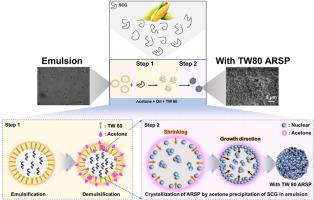Size-controlled interfacial crystallization of A-type resistant starch microparticles via acetone precipitation
IF 11
1区 农林科学
Q1 CHEMISTRY, APPLIED
引用次数: 0
Abstract
Short-chain glucan (SCG) recrystallization has emerged as an effective approach for producing resistant starch microparticle (RSP), which hold promise in both food science and clinical nutrition. This study introduces a novel method utilizing Tween 80 (TW80) to mediate the interfacial recrystallization of SCG into A-type crystalline RSP (ARSP) through acetone precipitation. TW80 plays a crucial role by stabilizing water-in-oil microemulsion droplets within acetone-oil mixtures, facilitating the formation of uniform and spherical ARSP ranging in size from 0.2 μm to 2 μm. The surface characteristics of ARSP, including porosity and smoothness, are notably influenced by SCG concentration. As SCG concentration increases, the melting temperature of ARSP rises from 117 °C to 145 °C, accompanied by a decrease in average surface area from 12.07 to 8.35 m2/g, alongside an increase in crystallinity. Moreover, the in vitro digestion test revealed that the digestion rate of ARSP was decreased from 0.73 h−1 to 0.39 h−1 with increasing SCG concentration, while increasing the resistant starch (RS) content in ARSP from 48.6% to 70.5%. This enhancement offers a strategic approach for modulating the digestion rate of ARSP, presenting opportunities for tailored release profiles and improved stability in food science applications. These findings underscore the potential of ARSP as a functional ingredient with significant implications for nutritional and clinical settings.

通过丙酮沉淀实现 A 型抗性淀粉微颗粒的尺寸控制界面结晶
短链葡聚糖(SCG)重结晶已成为生产抗性淀粉微粒(RSP)的一种有效方法,在食品科学和临床营养学中都大有可为。本研究介绍了一种利用吐温 80(TW80)介导 SCG 通过丙酮沉淀界面重结晶成 A 型结晶 RSP(ARSP)的新方法。TW80 通过稳定丙酮-油混合物中的油包水微乳液液滴发挥了关键作用,促进了大小从 0.2 μm 到 2 μm 的均匀球形 ARSP 的形成。ARSP 的表面特性(包括孔隙率和光滑度)明显受到 SCG 浓度的影响。随着 SCG 浓度的增加,ARSP 的熔化温度从 117 ℃ 升至 145 ℃,平均表面积从 12.07 平方米/克降至 8.35 平方米/克,结晶度也随之增加。此外,体外消化试验表明,随着 SCG 浓度的增加,ARSP 的消化率从 0.73 h-1 降至 0.39 h-1,同时 ARSP 中的抗性淀粉(RS)含量从 48.6% 增加到 70.5%。这种改进为调节 ARSP 的消化率提供了一种战略方法,为食品科学应用中定制释放曲线和提高稳定性提供了机会。这些发现强调了 ARSP 作为功能性配料的潜力,对营养和临床应用具有重要意义。
本文章由计算机程序翻译,如有差异,请以英文原文为准。
求助全文
约1分钟内获得全文
求助全文
来源期刊

Food Hydrocolloids
工程技术-食品科技
CiteScore
19.90
自引率
14.00%
发文量
871
审稿时长
37 days
期刊介绍:
Food Hydrocolloids publishes original and innovative research focused on the characterization, functional properties, and applications of hydrocolloid materials used in food products. These hydrocolloids, defined as polysaccharides and proteins of commercial importance, are added to control aspects such as texture, stability, rheology, and sensory properties. The research's primary emphasis should be on the hydrocolloids themselves, with thorough descriptions of their source, nature, and physicochemical characteristics. Manuscripts are expected to clearly outline specific aims and objectives, include a fundamental discussion of research findings at the molecular level, and address the significance of the results. Studies on hydrocolloids in complex formulations should concentrate on their overall properties and mechanisms of action, while simple formulation development studies may not be considered for publication.
The main areas of interest are:
-Chemical and physicochemical characterisation
Thermal properties including glass transitions and conformational changes-
Rheological properties including viscosity, viscoelastic properties and gelation behaviour-
The influence on organoleptic properties-
Interfacial properties including stabilisation of dispersions, emulsions and foams-
Film forming properties with application to edible films and active packaging-
Encapsulation and controlled release of active compounds-
The influence on health including their role as dietary fibre-
Manipulation of hydrocolloid structure and functionality through chemical, biochemical and physical processes-
New hydrocolloids and hydrocolloid sources of commercial potential.
The Journal also publishes Review articles that provide an overview of the latest developments in topics of specific interest to researchers in this field of activity.
 求助内容:
求助内容: 应助结果提醒方式:
应助结果提醒方式:


